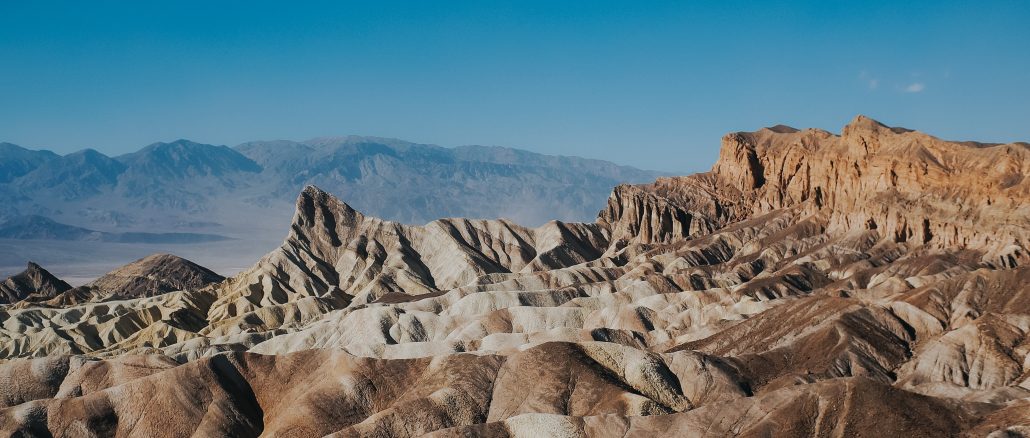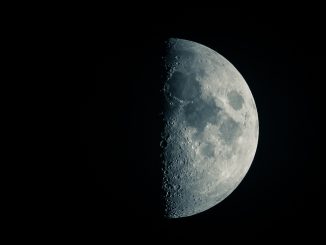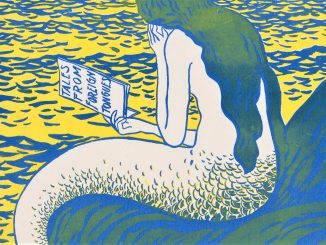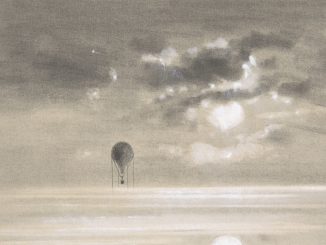
Getting caught in a sandstorm in Death Valley makes for gritty contemplation. The aptly named National Park puzzles the author with its past secrets and possible previews of the future. Did a professional dancer really perform without an audience for decades in this desert? Will tougher conditions for all homo sapiens force more empathy from us? Join Tom Molanphy in this memorable tour of Death Valley National Park.
On the Mountain
The wind gusts had knocked the know-it-all smarm out of my iPhone quicker than a downloaded app. The whole point of the four-mile hike to Death Valley’s Wild Rose Peak was to photo what could not be captured anywhere else: a view of both the lowest point in North America (-282 foot Badwater Basin) and the highest point in the contiguous United States (+14,505 foot Mt. Whitney.) But try gripping a 3 mm wide camera as sixty mph winds take potshots. You end up with photos of fleshy monsters crushing the tiny heads of tiny peaks.
The early spring cold front carried whispy clouds that obscured most of our view of Death Valley National Park. But we could clearly see that something bad was brewing down in Badwater.
“That doesn’t look good,” my wife said, literally holding onto her hat.
The brown blur of a dust storm marched down the valley and smudged the world between us and our car. If I added an old greybeard with stone tablets nestled in both arms, the scene became downright Biblical.
The storm reminded me of an e-mail a friend sent the day before we left for our week vacation. “Margins are thin in the desert,” David Johns, founder of the Wildlands Project told me. “Not a lot of room for being stupid or self-indulgent.” He said a Haitian marine conservationist once told him that the future human world would likely be quite impoverished. “We had a very interesting conversation about how to act in such a world … desert living may generate empathy, at least in some circumstances.”
Could less draw more out of us? Mary Austin, the Death Valley sage and author of the iconic The Land of Little Rain, recalls finding a hawk and a sparrow, predator and prey, sitting right next to one another under the mid-afternoon blaze of Death Valley, “with wings trailed and beaks parted, drooping in the white truce of noon.” Edward Abbey, that desert kook who had more patience for the eternal sands of time than for humanity, thought that the “extreme clarity of the desert light is equaled by the extreme individuation of desert life forms. Love flowers best in openness and freedom.” The simple starkness of the desert seemed to put everything in its proper context for Georgia O’Keefe. “Sun-bleached bones were most wonderful against the blue – that blue that will always be there as it is now after all man’s destruction is finished.”
My wife and I headed down the mountain into the storm. I wondered who came to the Death Valley, and why, and if the desert’s extreme nature caused their empathies to blossom or collapse.
The desert made them do it
Death Valley’s most famous resident, “Death Valley Scotty,” was Walter Scott for most of his tumbleweed life. After running away from his Kentucky home as a boy, he eventually wound up with Buffalo Bill’s Wild West Show in 1890. After twelve years of touring the world with the show, Scott caught gold fever and did his best to spread it, luring a cadre of East Coast businessmen to invest in a “find” he had in Death Valley. The fat cats were so gripped by the prospect they sent a stranger on the other side of the continent thousands of dollars just for the chance of a strike.
But common sense can find even the richest of men. When more excuses than gold piled up from Scott, all the investors pulled out except for one: Chicago insurance magnate Albert Mussey Johnson. Maybe it was Johnson’s religious convictions that kept his faith in his fellow man, but, for whatever reason, he kept funneling Scotty money for years. Finally, his faith strained to the breaking point, Johnson decided to check on the progress himself.
When Scotty got wind that his blind-faith benefactor was headed his way, he planned his defense: he would take the trusting East Coast investor on a rough ride through merciless Death Valley, wandering on horseback until his “guest” had had enough. And if it had not been for the desert’s miraculous affects on Mr. Johnson, Scotty might have pulled the scam off. Johnson had suffered bad health since a train-accident in his childhood, and no amount of money had been able to buy him good health. The thin air and constant heat energized his constitution, and the stark beauty of the desert charmed his heart. Johnson discovered that Death Valley itself was the treasure he had been seeking.
What happened next seems more miraculous, since it involves not the proven renewable qualities between man and nature but the jagged history between man and man. Instead of hauling Death Valley Scotty off to jail (or at least socking him a good one), the rich man and the poor scoundrel struck up a lifelong friendship, building a hotel together and finding common ground in one of the most barren places on earth. Their peculiar friendship lasted until Johnson’s death in 1948, with Scotty entertaining guests from Errol Flynn to Will Rogers with his corny witticisms ( “I got four things to live by: Don’t say nothing that will hurt anybody. Don’t give advice—nobody will take it anyway. Don’t complain. Don’t explain.”) and Johnson picking up every bar tab and legal fee.
“Scotty just likes to spend money. And I like to see him spend it,” Johnson said with a smile.
Build It and No One Will Come
Marta Becket came to the Death Valley in 1965, and the story has to be pictured to be believed.
Start here: a ballet dancer is wandering through the desert. She just left her husband who was fixing the flat on their trailer. She finds an old adobe building in Death Valley Junction, a dusty town choking in the center of North America’s largest desert. Something draws her to the broken structure, maybe unfulfilled dreams of a young dancer at Radio City Music Hall. Through a hole in the door she sees a small stage and several wooden benches. A theatre, of all things in all places, just waiting for a performance. Her wild, wandering heart finally finds its home.
Becket ran the Amargosa Opera House and hotel until her death in January 2017, a few weeks before our visit. I had read her obit in the New York Times and watched the Oscar-nominated documentary on Becket where she shared the mythologized moment when she decided to stay in Death Valley.
The ramshackle reality of the actual Amargosa, though, was another story. Reality set in as clear and hard as the wind-blasted hardpan desert as soon as we put our bags down in our room. The hotel was in dire financial straights, and the near poisonous effects of old plumbing were the star of the “Welcome” sign on our door: The Death Valley Junction Water System Has Levels of Coliform Bacteria Above the Drinking Water Standard.
We left our bags unpacked and headed to the public area, a mothbally living room with a sloped floor and dusty lights. The Oscar-nominated film, Amargosa, was playing in an almost continuous loop. It was hard to not be mesmerized by the ethereal Becket, especially her description of the creative sanctuary she found in the desert. She left all her family and friends in New York, lost her husband to her obsession, and was stripped of everything but her art—which at times had almost no audience.
No matter: from opening night on Feb. 10, 1968, until 2012, Marta performed. She painted an audience onto the walls of the old theatre, since just the idea of an audience was all the introvert performer needed. “Tears came to my eyes,” Ray Bradbury said when he watched Marta perform for the first time. “Marta represented to me the spirit of the individual. The spirit of the theater. The spirit of creativity.”
Had the desert drawn this from her? Maybe she was born this way, an outsider who finally found the ultimate outside, or maybe her eccentricity was just the result of too much sun exposure. Or maybe, just maybe, she had discovered the secret of nature that Gretel Ehrlich once described: “Everything in nature invites us constantly to be what we are.”
Apocalypse Later
If you happened to wander into Death Valley in 1975, you’d see a clear vision of the future. The glint of a tall, golden android next to a rolling, tilted tin can, the computerized descendants of Laurel and Hardy. An Asian elephant named Mardji, trucked all the way from an animal park in Vallejo, CA, with enormous fake horns strapped to her head and a wooly mane flopped over the poor animal stumbling through the desert. A parallelogram on wheels, so big it blotted out part of the horizon, a replica of the one that had been blown away in a Tunisian desert months before. And the architect of all this madness was a bearded and bespectacled director with a neck that wouldn’t quit.
Forty years later, it’s hard to believe that Star Wars, with its billion-dollar revenue snaking through cinematic history like Jabba’s hungry tongue, was turned down by two major studios and made by a novice that simply hoped this film would not be his last.
“I was reaching for the stars and had enough money for Cleveland,” George Lucas once said about his iconic film.
Although Tunisia had been the location for the majority of the desert filming, Lucas chose Death Valley for some fixes because it was close to his editing studio in LA. What both tortured and sustained him was his obsessive commitment to his vision, a vision that had him locked in the top floor of his Marin house for eight hours a day for years, staring at a typewriter, desperate for the right words to describe his galaxy far, far away.
That same dedication brought him to this second desert location to get the thing right. Part of that dedication seemed to rest on his belief that Star Wars was the right film for the wrong times that surrounded him. His contemporaries, like Stephen Spielberg and Martin Scorsese, plugged into the anxieties of the mid to late seventies with films like Jaws and Mean Streets. Lucas’s closest friend—and greatest rival—Francis Ford Coppola had even asked Lucas to join him in making Apocalypse Now. But Lucas was certain the world needed less of the Vietnam violence and Watergate distrust of the ’70s and more of the oft-forgot subtitle of his film, A New Hope.
“I thought, ‘we all know what a terrible mess we have made of the world,” said Lucas, as quoted in Brian Jay Jones definitive 2016 biography of Lucas, George Lucas: A Life. “We also know, as every movie made in the last ten years has pointed out, how terrible we are and how rotten everything is. And I said, what we really need is something more positive.”
His desert vision of the future is not sparkling and glamorous, but more rough and worn. The most lasting shot of the entire Star Wars saga, the one praised by critics who otherwise regard his work as pop fluff, is the shot of Luke Skywalker, the poor farmer boy, staring off into the open possibilities of the desert. Lucas said that shot was “the one that came closest to getting across what I really meant” in the films. The shot suggests that the expanse of the desert—and the endless possibility of the future—can be cause for hope.
Down the Mountain
We descended Wildrose Peak, and the desert rose to meet us. By the time we arrived at our black rental car, the whirling sand had found most of my edges—the corners of my eyes, underneath the scruff of my three-day unshaven face, and somehow in the small back of my throat where it couldn’t be swallowed down or coughed up. Shelter in the Amargosa Hotel was forty miles away, ten on a washboard dirt road getting more scuffed by the minute.
The one silver lining of a desert storm is that there’s not much for the sixty mile per hour gusts to pick up. The buffeting winds kept both of my hands on the wheel as the occasional tumbleweed torpedoed our hood. Low visibility craned me over the steering wheel, but we made it to the half-way point of Stovepipe Wells in one piece. On the far edge of town, though, a National Park Ranger who looked just like Bradley Cooper (from American Sniper, not Hangover) blocked the road with his green SUV. He adamantly pointed each and every car to the side of the road from inside his car.
We followed orders. I hopped out and walked over to Mr. Cooper, sand shoveling up on either side of the road and floating across the asphalt in grand waves. The ranger sat stoically in his car, the stand-up shotgun rack next to him and his wrap-around sunglasses perfecting his Cooper/Sniper look. He told me this dust storm was a particularly bad one.
“Visibility past this point is zero. Stay put until this one plays out.”
Inside the gas station, a small but intense international dust-up of its own was playing out. A large woman behind the cash register was loudly explaining to Germans, Italians, Japanese, and others that the static electricity form the storm was creating havoc with the credit card machines and the gas pumps. In short, Mother Nature had won this round against technology.
“No gas, folks,” she said cheerfully but forcefully. I was left to wander between aisles of powdered donuts and soft drinks among frustrated cultures whose credit cards had just become useless plastic. Individual survival instincts seemed to beat any sense of common empathy, at least inside the convenience store.
Back inside the car, we felt an electricity stronger than static build up around us. More and more cars were being pointed to either side of the road. World travelers who had come for the planned experience of nature had discovered that the truth about nature could be, well, inconvenient. Two small parking lots filled and then flooded with cars, wedged every which way like a diabolical game of Tetris.
We all, of course, turned to our phones for answers, our most immediate source of empathy. My iPhone was just as useless as it had been on Wild Rose Peak. Zero bars meant we were all imprisoned in the hell of other people, and the angst re-doubled and swirled both inside and outside of cars. I dumbly considered my lame iPhone and sunk lower than Badwater Basin. Maps were unfolded on dashes, seatbelts unbuckled, and the wait was on. The idea that the limited resources of a desert could make a rich man forgive a poor thief, or inspire a dancer to perform out of sheer joy, or a film director to lay out a hopeful version of the future felt far, far away.
When Bradley Cooper pulled his SUV to the side and signaled we could all go, go we all did. At once, and from all sides, in as disorderly and honking and unfashionable way as possible. We did not act like individuals inspired by scarcity but like a herd of cattle. Too big to succeed, regarding each other as inelegantly and as inhumanly as cars versus cars.
Later, most of us, or some, may have felt bad about the way we behaved. But we’d still do it again and again and again. Until empathy—or something else—caught up to us.
 TOM MOLANPHY‘s journalism has appeared in SF Weekly, Earth Island Journal, The San Francisco Chronicle, USA Today/10Best.com, and 7×7. His short story “Of Subareas and Public Bathrooms” was included in the California Prose Directory, 2013. Loud Memories Of A Quiet Life, his latest book, is available through OutPost19 Press. He earned his MFA in Creative Writing from the University of Montana. Tom teaches journalism, creative writing and composition at the Academy of Art University in San Francisco.
TOM MOLANPHY‘s journalism has appeared in SF Weekly, Earth Island Journal, The San Francisco Chronicle, USA Today/10Best.com, and 7×7. His short story “Of Subareas and Public Bathrooms” was included in the California Prose Directory, 2013. Loud Memories Of A Quiet Life, his latest book, is available through OutPost19 Press. He earned his MFA in Creative Writing from the University of Montana. Tom teaches journalism, creative writing and composition at the Academy of Art University in San Francisco.
Twitter: @tmolanphy
sfweekly.com/author/tom-molanphy
Featured image: Photograph by Meriç Dağlı on Unsplash.


